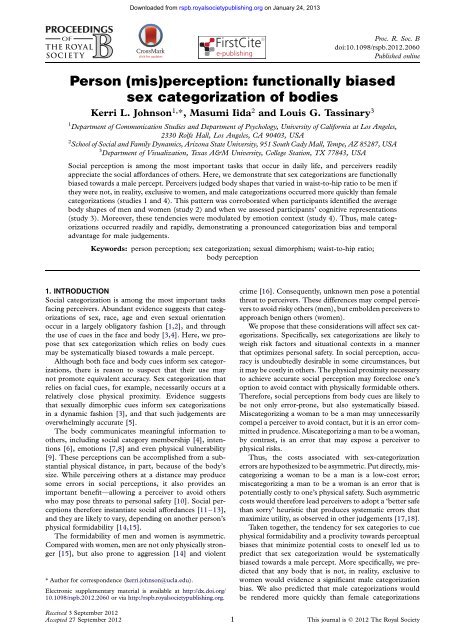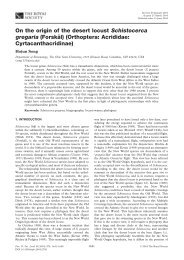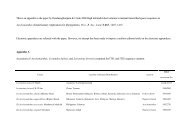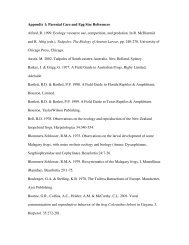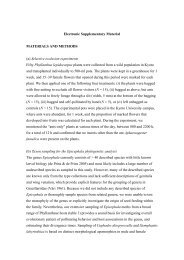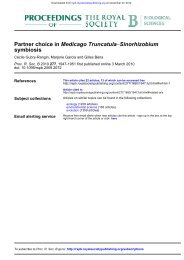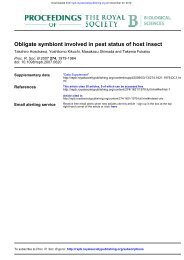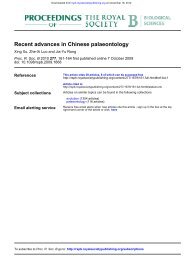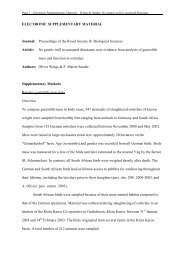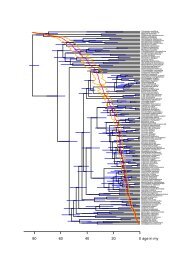Person (mis)perception: functionally biased sex categorization of ...
Person (mis)perception: functionally biased sex categorization of ...
Person (mis)perception: functionally biased sex categorization of ...
You also want an ePaper? Increase the reach of your titles
YUMPU automatically turns print PDFs into web optimized ePapers that Google loves.
Downloaded from<br />
rspb.royalsocietypublishing.org on January 24, 2013<br />
<strong>Person</strong> (<strong>mis</strong>)<strong>perception</strong>: <strong>functionally</strong> <strong>biased</strong><br />
<strong>sex</strong> <strong>categorization</strong> <strong>of</strong> bodies<br />
Kerri L. Johnson 1, *, Masumi Iida 2 and Louis G. Tassinary 3<br />
1 Department <strong>of</strong> Communication Studies and Department <strong>of</strong> Psychology, University <strong>of</strong> California at Los Angeles,<br />
2330 Rolfe Hall, Los Angeles, CA 90403, USA<br />
2 School <strong>of</strong> Social and Family Dynamics, Arizona State University, 951 South Cady Mall, Tempe, AZ 85287, USA<br />
3 Department <strong>of</strong> Visualization, Texas A&M University, College Station, TX 77843, USA<br />
Social <strong>perception</strong> is among the most important tasks that occur in daily life, and perceivers readily<br />
appreciate the social affordances <strong>of</strong> others. Here, we demonstrate that <strong>sex</strong> <strong>categorization</strong>s are <strong>functionally</strong><br />
<strong>biased</strong> towards a male percept. Perceivers judged body shapes that varied in waist-to-hip ratio to be men if<br />
they were not, in reality, exclusive to women, and male <strong>categorization</strong>s occurred more quickly than female<br />
<strong>categorization</strong>s (studies 1 and 4). This pattern was corroborated when participants identified the average<br />
body shapes <strong>of</strong> men and women (study 2) and when we assessed participants’ cognitive representations<br />
(study 3). Moreover, these tendencies were modulated by emotion context (study 4). Thus, male <strong>categorization</strong>s<br />
occurred readily and rapidly, demonstrating a pronounced <strong>categorization</strong> bias and temporal<br />
advantage for male judgements.<br />
Keywords: person <strong>perception</strong>; <strong>sex</strong> <strong>categorization</strong>; <strong>sex</strong>ual dimorphism; waist-to-hip ratio;<br />
body <strong>perception</strong><br />
1. INTRODUCTION<br />
Social <strong>categorization</strong> is among the most important tasks<br />
facing perceivers. Abundant evidence suggests that <strong>categorization</strong>s<br />
<strong>of</strong> <strong>sex</strong>, race, age and even <strong>sex</strong>ual orientation<br />
occur in a largely obligatory fashion [1,2], and through<br />
the use <strong>of</strong> cues in the face and body [3,4]. Here, we propose<br />
that <strong>sex</strong> <strong>categorization</strong> which relies on body cues<br />
may be systematically <strong>biased</strong> towards a male percept.<br />
Although both face and body cues inform <strong>sex</strong> <strong>categorization</strong>s,<br />
there is reason to suspect that their use may<br />
not promote equivalent accuracy. Sex <strong>categorization</strong> that<br />
relies on facial cues, for example, necessarily occurs at a<br />
relatively close physical proximity. Evidence suggests<br />
that <strong>sex</strong>ually dimorphic cues inform <strong>sex</strong> <strong>categorization</strong>s<br />
in a dynamic fashion [3], and that such judgements are<br />
overwhelmingly accurate [5].<br />
The body communicates meaningful information to<br />
others, including social category membership [4], intentions<br />
[6], emotions [7,8] and even physical vulnerability<br />
[9]. These <strong>perception</strong>s can be accomplished from a substantial<br />
physical distance, in part, because <strong>of</strong> the body’s<br />
size. While perceiving others at a distance may produce<br />
some errors in social <strong>perception</strong>s, it also provides an<br />
important benefit—allowing a perceiver to avoid others<br />
who may pose threats to personal safety [10]. Social <strong>perception</strong>s<br />
therefore instantiate social affordances [11–13],<br />
and they are likely to vary, depending on another person’s<br />
physical formidability [14,15].<br />
The formidability <strong>of</strong> men and women is asymmetric.<br />
Compared with women, men are not only physically stronger<br />
[15], but also prone to aggression [14] and violent<br />
* Author for correspondence (kerri.johnson@ucla.edu).<br />
Electronic supplementary material is available at http://dx.doi.org/<br />
10.1098/rspb.2012.2060 or via http://rspb.royalsocietypublishing.org.<br />
Proc. R. Soc. B<br />
doi:10.1098/rspb.2012.2060<br />
Published online<br />
crime [16]. Consequently, unknown men pose a potential<br />
threat to perceivers. These differences may compel perceivers<br />
to avoid risky others (men), but embolden perceivers to<br />
approach benign others (women).<br />
We propose that these considerations will affect <strong>sex</strong> <strong>categorization</strong>s.<br />
Specifically, <strong>sex</strong> <strong>categorization</strong>s are likely to<br />
weigh risk factors and situational contexts in a manner<br />
that optimizes personal safety. In social <strong>perception</strong>, accuracy<br />
is undoubtedly desirable in some circumstances, but<br />
it may be costly in others. The physical proximity necessary<br />
to achieve accurate social <strong>perception</strong> may foreclose one’s<br />
option to avoid contact with physically formidable others.<br />
Therefore, social <strong>perception</strong>s from body cues are likely to<br />
be not only error-prone, but also systematically <strong>biased</strong>.<br />
Miscategorizing a woman to be a man may unnecessarily<br />
compel a perceiver to avoid contact, but it is an error committed<br />
in prudence. Miscategorizing a man to be a woman,<br />
by contrast, is an error that may expose a perceiver to<br />
physical risks.<br />
Thus, the costs associated with <strong>sex</strong>-<strong>categorization</strong><br />
errors are hypothesized to be asymmetric. Put directly, <strong>mis</strong>categorizing<br />
a woman to be a man is a low-cost error;<br />
<strong>mis</strong>categorizing a man to be a woman is an error that is<br />
potentially costly to one’s physical safety. Such asymmetric<br />
costs would therefore lead perceivers to adopt a ‘better safe<br />
than sorry’ heuristic that produces systematic errors that<br />
maximize utility, as observed in other judgements [17,18].<br />
Taken together, the tendency for <strong>sex</strong> categories to cue<br />
physical formidability and a proclivity towards perceptual<br />
biases that minimize potential costs to oneself led us to<br />
predict that <strong>sex</strong> <strong>categorization</strong> would be systematically<br />
<strong>biased</strong> towards a male percept. More specifically, we predicted<br />
that any body that is not, in reality, exclusive to<br />
women would evidence a significant male <strong>categorization</strong><br />
bias. We also predicted that male <strong>categorization</strong>s would<br />
be rendered more quickly than female <strong>categorization</strong>s<br />
Received 3 September 2012<br />
Accepted 27 September 2012 1 This journal is q 2012 The Royal Society


